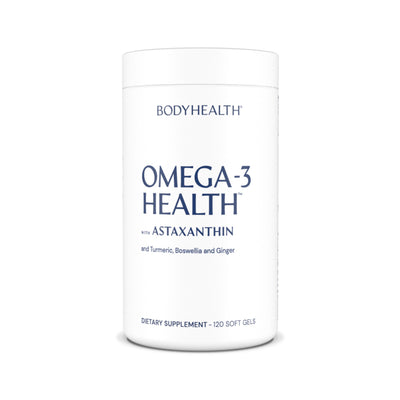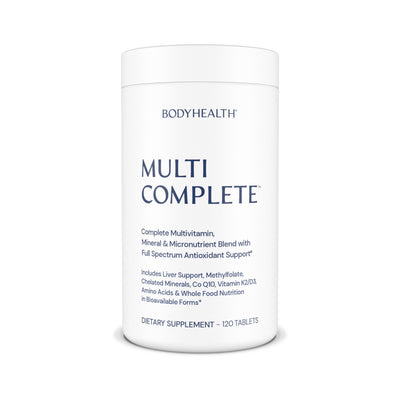What Causes High Blood Pressure: How Our Heart Works
by Dr David Minkoff February 18, 2024 7 min read

Disclaimer: This article is purely informational and makes no claims as to treatment or cure by or from any supplement or program BodyHealth may offer. If you or someone you know has any heart condition, we recommend you see a doctor trained in functional medicine to help you locate the cause of the disease or condition and recommend a solution for it.
In the last article in the Heart Health Series we covered how consuming cholesterol is not actually the cause of heart disease.
And how lowering cholesterol levels with drugs, to lower high blood pressure, actually increases the risk of heart disease among those 60 and above.
But while the idea that cholesterol intake causes heart disease may be a myth, heart disease itself is quite real.
In this article we’ll dive more into this, covering what high blood pressure is, why and how it occurs, and what’s actually behind it.
OXYGENATING OUR CELLS: THE CARDIOVASCULAR SYSTEM
When we say we need oxygen to survive, we’re really saying that our cells need oxygen to survive. Because our bodies are nothing more than a conglomeration of cells working together.
After about 5 minutes of low or no oxygen, cells begin to die.
This is because of something called ATP (Adenosine Triphosphate), the energy, or “food”, our cells live on.
ATP is made within the cell by combining oxygen with glucose (sugar), or ketones (energy from fat), or amino acids (from protein).
ATP is made by tiny organelles within each cell called mitochondria. There are about 1000-2500 mitochondria in each cell.
When we breathe in oxygen, our blood cells take in this oxygen and transport it to our cells. Nutrients (glucose, fats and amino acids) are also transported to the cells.
The mitochondria inside the cells then take the oxygen and food source (sugar, fat or amino acid) they receive and create ATP from it, which the cell then uses as energy to fuel itself.
And, as the cells are always working, they need a constant source of ATP to carry on.
This is the energy that powers our body.
So we breathe in. The oxygen goes into our lungs and then into red blood cells. The red blood cells transport the oxygen to our cells where the mitochondria mix it with nutrients to make energy.
If we remove oxygen completely, the cells can’t make ATP and so don’t have the fuel they need to operate. So they die. So we die.
Or, if our blood oxygen levels are just lower than usual, the mitochondria produce less ATP, so the cells have less energy.
Which means we have less energy.
It really is that simple.
But, let’s look deeper.
When oxygen levels to our cells are lower, then cell turn-over rates decline. Cell replication, which is needed for muscle building, healing, and general replacing of old cells, declines.
Our strength drops, our energy levels drop and, as our cells are not being replaced as often, we “age” as there are fewer new cells made, even for our skin.
Why? Because our cells need energy to perform all of these actions.
And if they have lower levels of oxygen, or of glucose, fats or amino acids, then they don’t have what they need to make the energy to perform all of these actions.
So they only perform the most vital actions. So healing is slower, energy levels are lower, we get brain fog, etc.
When this happens we increase our breathing to bring in more oxygen. And our heart rate increases to push oxygenated red blood cells through our bodies to the cells so they can get the oxygen and make fuel.
And this is where high blood pressure comes in.
BLOOD PRESSURE, OXYGEN & FEELING OUT OF BREATH
The above is fairly simple, overall.
The cells need oxygen to make energy so they can survive. If they don’t get enough, then they can’t make enough energy. And if they get no oxygen then they can’t make any energy and die.
Let’s look at an example of this.
If you go running your body is using more energy. Your cells are using more energy.
So they have to make more energy. This means they need more oxygen. So you breathe more to get more oxygen to them and your heart rate goes up to get this oxygen to them.
If the cells get to the point where they can’t get enough oxygen to make enough energy to keep powering our activity, then we feel it.
It’s called “feeling out of breath.” When you’re jogging or working hard and you start to feel “out of breath,” like you “just can’t get in enough air,” that’s actually coming from the cells.
They need the oxygen and you aren’t breathing in enough of it and/or your heart isn’t getting it to them fast enough so they can keep up with the demands being put on them.
So what’s the difference between one person feeling out of breath running and another not feeling out of breath?
This can come from two things.
First, people who exercise more often build up more mitochondria, the organelles that make energy from this oxygen. If you have more energy makers, then you have more energy.
But usually it’s from blood flow. And this is where blood pressure comes in.
If the heart needs to get oxygenated blood cells to the body’s cells faster, then it needs to increase pressure to push the blood through the blood vessels.
It pumps harder and more times per minute to do this.
But these red blood cells have an exact size. They’re about 6-8 microns in diameter (a micron is 1/1000th of a millimeter).
But the size of the blood vessels these red blood cells are traveling through can be smaller than the red blood cells themselves.
Capillaries are the smallest blood vessels in the body, taking oxygenated red blood cells to each of our cells.
While they can be larger, the passageways in most capillaries are only about 3-4 microns in width, smaller than the blood cells that pass through them.
These red blood cells have to squish and elongate themselves to pass through these narrow passages. And they do so because of the pressure of the blood pushing them through.
That’s “blood pressure”. And that’s normal.
But what happens when these capillaries become even more narrow?
What if they become 2 microns in width?
Then it’s harder for a blood cell to pass through them. They can’t squish down enough. So the heart has to beat harder, to raise blood pressure, to push them through.
Because they need to get through. Because your cells will die without the oxygen they contain and your body is nothing but your cells.
This is why some people get out of breath easier than others. Their blood vessels have become more narrowed so it’s harder for blood cells to get through to get oxygen to their cells.
Over time, while not killing a person, this can result in parts of their body getting less and less oxygen.
They can start to feel pain or numbness in these areas, or lowered motor control or strength. Injuries don’t heal as well.
All because narrowed blood vessels are preventing some of the oxygen from getting to these areas.
And this has been pinned on cholesterol in the blood vessels, from cholesterol that you ate, that then narrowed the blood vessels.
But it’s not.
HIGH BLOOD PRESSURE & CHOLESTEROL
I’m going to jump back to cholesterol for a moment here.
When the inside walls of our blood vessels are injured, much like a scrape on the knee, our body puts a scab on it, a bandage.
If you scrape your knee, the scab is made, largely, of special blood cells called platelets, which clump together and dry out, forming the scab.
But inside your blood vessels, that “scab” or bandage is made of… cholesterol.
And that’s where the confusion comes from.
Because this isn’t a point of you ate cholesterol, and then that cholesterol went and formed a scab.
No. There was an injury to the blood vessel caused by toxins, or high levels of sugar, or trans fats or something else in your blood, and cholesterol was brought in to bandage that injury.
It has to be bandaged. It’s a blood vessel. What do you think happens if a hole starts to form there? Of course it needs to be fixed.
But that’s where cholesterol comes in. It doesn’t, on its own, build up in our blood vessels. It goes there as a reaction and solution to an injury that something else caused.
So the solution here isn’t to take away your body’s ability to bandage an injury, the solution is to remove the items that caused the injury which cholesterol was then needed to fix, and then to heal the injury.
But this cholesterol does push out into the inside passage of the blood vessel and take up space, narrowing the passageway for blood cells to get through.
So our heart needs to raise blood pressure to push the blood cells through to get oxygen to our cells.
If we really want to improve things, we need to find and address the things that are causing these injuries.
And we’ll cover that in the next article.
THREE THINGS TO IMPROVE BLOOD FLOW
There are two things that significantly help blood flow.
The first is Omega 3 Fatty Acids.
We already know that these lower cortisol levels, high amounts of which cause injury to our blood vessels.
But they also help our cells to be “squishier” so they have an easier time pushing through our blood vessels.
So make sure you’re taking your Omega 3, as it’s quite deficient in meats and foods these days due to what these animals are being fed: corn and soy.
The other thing is Vitamin E. This is an amazing vitamin, and one thing it does is help break down scar tissue in the body.
You can even test this for yourself. If you get a cut and it scabs over, put some vitamin E on it. It will heal faster, with visibly less scar tissue.
But this works within the body as well.
It also helps to increase oxygenation of our blood cells.
Our Multi Complete contains 400mg of vitamin E per serving.
And cut out processed sugars.
High amounts of sugar have a reaction on blood of causing it to thicken, thus making it even harder to push through the blood vessels.
While there is more to cover, these three things can significantly improve overall heart health and cardiovascular health.
I hope this helps.
Articles by Health Topic
Get “The Search for the Perfect Protein”
by Dr. David Minkoff
Signup for the BodyHealth Newsletter and get a FREE digital copy of "The Search for the Perfect Protien" by Dr. David Minkoff and discover the key to weight loss, depression, fatigue, insomnia, and osteoporosis!
*These statements have not been evaluated by the Food and Drug Administration. These products are not intended to diagnose, treat, cure, or prevent any disease.


